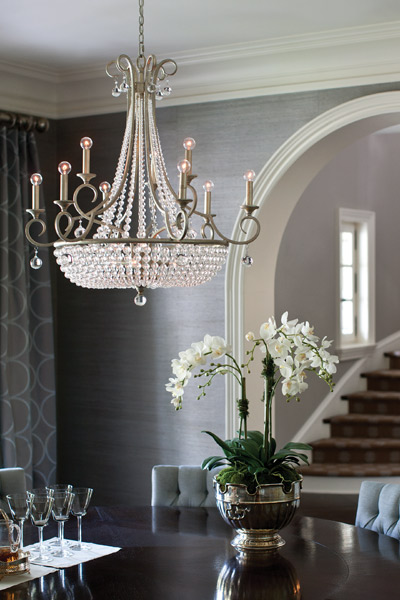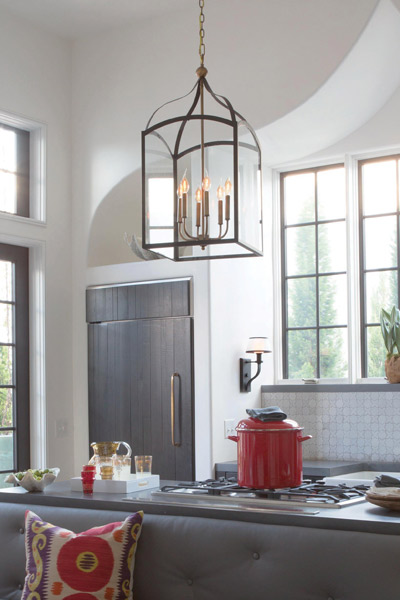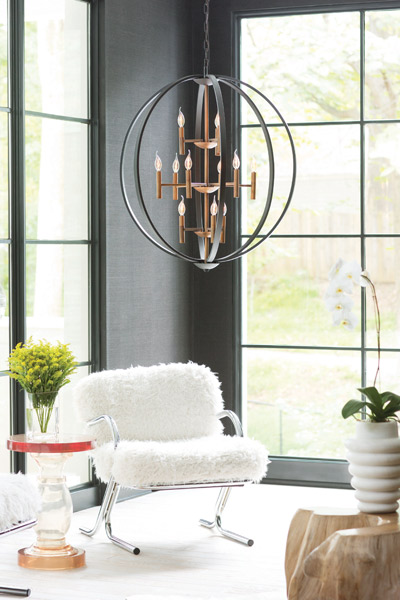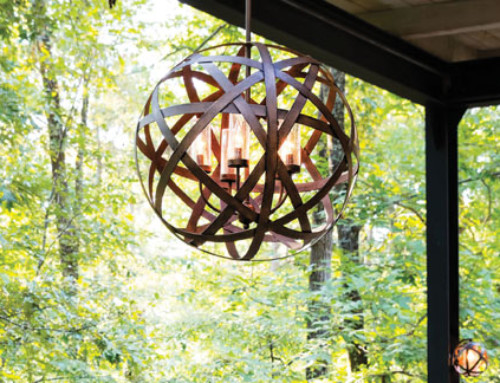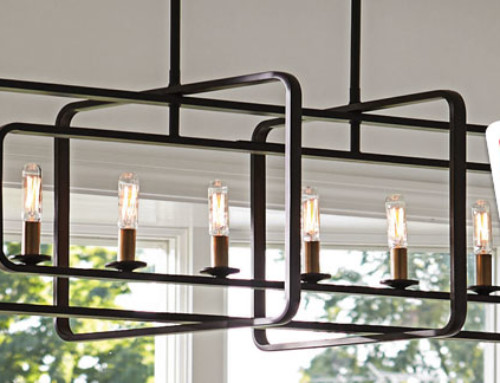A chandelier is usually the focal point of the room. Its style expresses your personality and acts as an anchor for the rest of the lighting fixtures in the room. For any space, the size of the chandelier should be in proportion to the size of the room. A large room can handle a substantial, bold chandelier, while a small room is better suited to a more modest style. As a general rule, the chandelier should be the focal point of the room, so it should be large enough to be noticed but not so large that it overpowers the room.
3 Steps to Size a Dining Room Chandelier
Our step-by-step guide will help you determine the general sizing and placement of a chandelier for your dining room, kitchen, or breakfast nook based on the size of your room, living space, or your furniture. You can also use these measurements in other areas of your home, some with special considerations. See our placement guidelines for living rooms, bathrooms, foyers, and long hallways below.
Step 1. Measure Room Length and Width to Determine Chandelier Width
Step 2. Measure Ceiling Height to Determine Height
Step 3. Measure Ceiling to Table to Determine Chain Length
Step 1. Determine Chandelier Width
– Measure the length and the width of the room
– Add the two measurements
– Convert the measurement unit from feet to inches
The converted sum is the ideal width (or diameter) of your chandelier. For example, if your dining room is 10′ x 18′, a chandelier with a 28″ diameter or width is the best fit for your space. This applies regardless of the shape of the chandelier. However, for round or rectangular fixtures, the length should be at least one-half, but not more than two-thirds the length of your table.
You can also use the square footage of your room to help estimate the size of chandelier that would be proportional. We’ve provided a quick reference chart below showing the appropriate width or diameter by square footage. Square footage is calculated by taking the length of the room multiplied by the width of the room. Using the example above, a 10’ x 18’ dining room would be 180 square feet, and a chandelier around 28” in diameter would be proportional.
Sizing By Table Size
To determine the width of your chandelier by the size of your table, assuming you have an open floor plan or just want to make the chandelier the centerpiece of the room, we recommend that the width or diameter of the chandelier should be one-half to two-thirds the width of the table. With ceilings over the standard eight feet, you base the size of the chandelier on the room size or living space. In this case, you would want to make sure the width of the chandelier is one foot less than the width of the table, to ensure six inches of clearance on either side of the table.
Hanging Two or More Chandeliers
A good place to start is to work with the rule of thirds. However, in this case we want to balance out the fixtures with the negative space. We have developed two formulas for how wide a chandelier should be in this situation.
Formula 1: Divide the length by 5 to calculate the three negative space values along with sizes for the chandeliers. For example: A 10’ long kitchen island or dining table divided by 5, gives you equal parts of negative space at 2’ along with 24” wide chandeliers. This is a great rule of thumb to start with.
Formula 2: Divide the overall length by 2, and then divide by 2 again. For a 10’ long table you would have 5’ (60”) then divided by 2 again to equal 30” fixtures. The distance between the fixtures should equal the diameter of each piece. Conclusion: Pick fixtures that are either 24” or 30” for a 10’ wide table and make sure to keep 24” or 30” between the chandeliers once installed.
*Source: Lightopia
Step 2. Determine Chandelier Height
– Measure the ceiling height, from the installation site to the floor. At this stage, ensure that the installation site is at least 4 feet away from any adjacent walls.
– For every foot, estimate 2.5″ to 3″ of chandelier height
– Multiply the ceiling height by the chandelier height
– Convert the measurement unit to inches
For example, if your dining room has an 8-foot ceiling, then a 24-inch chandelier is the best fit for your space. Click on the image below to print our chandelier sizing guide.
Please note: The above calculations assume you have a ceiling height proportional to the room size. Therefore, if you have a large room and a low ceiling, such as an open floor plan, or a high ceiling and a small room, such as a foyer, this may not apply. See our placement guidelines below to learn more.
Step 3. Determine Chain Length
If your ceiling is less than eight feet high, your dining room chandelier should hang 30″ to 34″ from the table top to the bottom of the chandelier and be centered over the table. If your ceiling is higher than eight feet high, the recommended clearance is 36 to 40 inches.
– Measure the ceiling to the tabletop in inches = _____
– Minus the recommended installation height = 32” (8’ or less ceiling) or 38” (>8’ ceiling)
– Minus the chandelier height determined in Step 2 above = _____
– Chain length = _______
Chandelier Placement by Room
If you are hanging a chandelier in another room of your house, it is recommended that there is at least seven feet clearance from the floor to the bottom of the chandelier. A chandelier can be hung in any room or corner of your home, from a finished basement to a walk-in closet, with that simple rule in mind. Here are some other placement guidelines by room to consider along with the recommended installation height:
Open floor plan
Centered over the living space, such as the living room set or over the coffee table, dining room set, or kitchen island. Simply use the approximate measurement of the space with the steps above to determine the correct diameter of the fixture.
Living Room
Centered in the room or over the coffee table. The recommended clearance of seven feet applies regardless of whether there is a coffee table or not. The most important consideration in this area is whether the chandelier will be the primary light source.
Bathroom
Centered over tub; at least eight feet of clearance from the edge of the tub to ceiling. Sizing can be determined by taking one-third the length of the tub. For safety reasons, we recommend using non-electrified chandeliers or wall sconces if placing over the tub and ceiling height does not allow for an eight-foot clearance. Centered in the room; at least 3 feet away from the tub.
Long Hallways
Centered in the middle of the hallway, spaced eight to ten feet apart, a minimum of an eight-foot clearance from floor to bottom of the chandelier is required. For low ceilings, we recommend flush mount chandeliers. Chandelier size is determined by the width of the hallway; each foot equals 2-2.5 inches in diameter. For example, if your hallway is five-foot-wide, the chandelier diameter would be 10-12 inches.
Standard Ceiling Foyer or Entryway
Centered over the foyer table or in the middle of the room. Sizing can be determined by the size of the room or the table. The most important concern in this area is the lighting of the space, as this is where your guest’s first impressions are made. You can go as dramatic or as bright as you desire. We recommend using matching wall sconces on either side of the foyer table as accents.
Two-Story Foyer with Staircase
Choose a two or three-tier chandelier in order to provide the best visual results. Regarding placement, it is important to acknowledge that there is no perfect answer for this as so many homes are different in this area, and there are many different tastes that will lead to different effects.
However, some general guidelines include hanging the chandelier slightly lower than or at the top of the staircase. In other words, if you were at the top of the staircase the top of the chandelier would be at eye-level. Many designers advocate for independent placement to make the fixture the focal point or placing the chandelier in relation to another architectural feature, such as tall windows or vaulted ceilings, to enhance the space as a whole.
Please contact a Wolberg Lighting certified lighting consultant with any questions. Contact Us >


